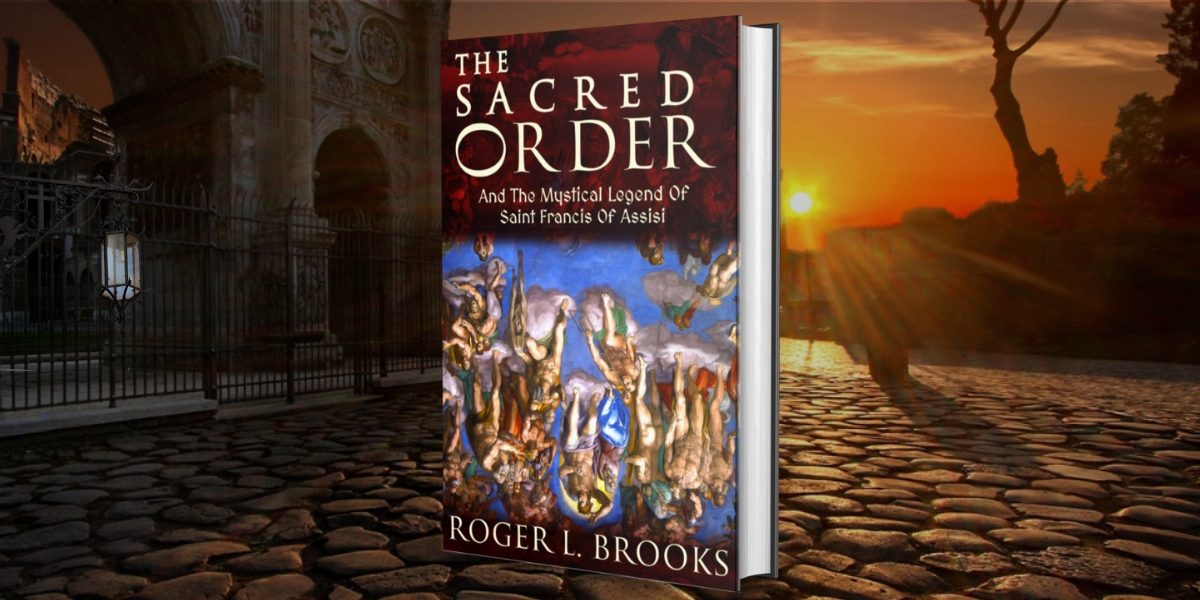By: Jonathan James
In the shadow of Assisi’s ancient basilica, a story has waited centuries to be told. This premise forms the backbone of Roger L. Brooks’ captivating debut novel, “The Sacred Order and the Mystical Legend of St. Francis of Assisi,” a work that skillfully blends historical thriller elements with profound spiritual inquiry. While the novel’s compelling plot is likely to captivate readers, it is the spiritual insights at its core that may resonate long after the final page is turned.
Brooks’ novel arrives at a time when many seek spiritual meaning beyond rigid institutional frameworks. The ongoing fascination with St. Francis of Assisi—the humble friar who gave up wealth to embrace simplicity—speaks to the contemporary search for authenticity in an age of materialism and division. Through his protagonist, Anthony Brunelli, Brooks invites readers to explore how Francis’s spirituality might address some of today’s pressing questions.
The Saint Who Transcends Time
Eight hundred years after his death, St. Francis of Assisi remains one of Christianity’s beloved figures, with his appeal extending far beyond Catholic circles. The novel explores why this medieval saint continues to capture our imagination, suggesting that Francis tapped into something timeless—a vision of interconnectedness that feels surprisingly relevant today.
“Francis wasn’t just a man of great intellect, but I’d argue that tale,” Brooks writes through his protagonist. “He had greater insight and foresight that could rival anyone in his day… He attained the ultimate state of mind, one of enlightenment, an intensity of love that continues to resonate today.”
This portrayal of Francis as a spiritual individual, rather than simply a gentle saint, gives “The Sacred Order” its intellectual depth. The novel reminds us that Francis’s embrace of poverty wasn’t an end in itself but a means to achieve spiritual freedom—a letting go that enabled him to see creation with unclouded clarity. In an era marked by constant consumption and distraction, this message holds significant relevance.
The Sacred Order Revealed
At the heart of Brooks’ novel lies the fictional “Sacred Order,” an ancient message from Francis himself, preserved through the centuries by a network of protectors, including artists, scholars, and Anthony’s own lineage. When this message is finally revealed, it shows to be both simpler and more profound than expected:
“You need not learn how to make your heart beat, nor how to set the sun aflame in its daily path. These marvels unfold as naturally as breathing, without toil or teaching,” reads part of the fictional document. “In truth, you are as the Eternal Weaver, spinning the living tapestry of existence, though you often remain unaware of your own skill.”
This mystical vision of unity with creation echoes both Francis’s Canticle of the Sun and contemporary discussions about consciousness and interconnectedness. By framing these ideas within a historical thriller, Brooks makes abstract spiritual concepts more tangible and accessible.
From Personal Transformation to Cultural Renewal
What elevates “The Sacred Order” beyond conventional historical fiction is its exploration of how personal spiritual awakening connects to broader cultural transformation. Through Anthony Brunelli’s journey from a successful yet spiritually disconnected artist to a reluctant mystic, Brooks charts a path many modern seekers may recognize.
The novel suggests that true spiritual insight cannot remain private but naturally flows outward into action. As Anthony discovers the Sacred Order’s meaning, he feels compelled to share its message with the world, culminating in a powerful address to the College of Cardinals before a papal election. This fictional scene, set against the backdrop of the actual 2013 conclave that elected Pope Francis, adds striking relevance to the novel.
Brooks writes: “The world is watching… only good can prevail. God has left the future state of His Church in your hands.” This message resonates beyond the fictional narrative, speaking to our collective responsibility to carry spiritual insights into the public sphere.
Art as Vessel for Transcendent Truth
One of the novel’s fascinating elements is its exploration of art as a vehicle for spiritual transmission. The plot hinges on Michelangelo’s encoding of secret messages within the Sistine Chapel frescoes, particularly The Last Judgment. This literary device serves a deeper purpose, suggesting that great art can preserve and communicate truths that may be too profound or dangerous for direct expression.
Anthony, as a contemporary photorealist painter, continues this tradition, finding that his artistic perception becomes key to unlocking Michelangelo’s hidden symbols. This portrayal of art as spiritual practice, rather than mere self-expression, challenges readers to consider how creativity might serve higher purposes in their own lives.
“Every painting, every commission is its own world, and once it’s done, you leave it behind,” Anthony reflects. “That’s the price of creating—you’re always moving, always searching.” This restless seeking finds resolution only when Anthony discovers the deeper purpose behind his artistic gifts.
A Spirituality for Our Time
Perhaps most compelling is how “The Sacred Order” presents Francis’s spirituality not as a relic of the past but as a living tradition with urgent relevance. The novel’s fictional “Sacred Order” echoes many of Francis’s actual teachings while speaking directly to contemporary spiritual seekers.
In a pivotal scene, the hermit Massimo explains to Anthony: “Francesco saw life as music. The goal of music is certainly not in the future but in the melody of the music itself. The goal of a symphony is not to reach the end of the symphony… And you don’t dance in order to arrive at a particular place on the floor. You dance to enjoy the dance. Francesco believed existence is a kind of dance.”
This emphasis on present-centered awareness, on perceiving the sacred within the ordinary, offers a counterpoint to both religious formalism and secular materialism. Brooks suggests that Francis’s greatest gift was his ability to see beyond conceptual divisions to the underlying unity of all things—a perspective increasingly supported by contemporary physics and ecology.
Truth Through Fiction
While “The Sacred Order” takes creative liberties with historical details—including a fictional account of Pontius Pilate leaving a confession regarding the Virgin Mary—these inventions serve the novel’s deeper exploration of how truth persists despite attempts to suppress it. The thriller elements provide a vehicle for exploring weighty themes of institutional corruption versus authentic spirituality.
The novel’s fictional antagonists, the Ramorosso, represent forces that have always resisted spiritual awakening, preferring power to truth. Yet the story ultimately suggests that such forces cannot prevail indefinitely against the human hunger for authentic connection with the divine.
In an era of institutional distrust and spiritual seeking, “The Sacred Order” offers a vision of renewal that acknowledges darkness while still affirming the possibility of light. Like Francis himself, who embraced Sister Death as part of life’s sacred wholeness, the novel refrains from easy optimism while maintaining profound hope.
A Literary Pilgrimage
Reading “The Sacred Order” becomes, in itself, a kind of literary pilgrimage to Assisi. Brooks’ vivid descriptions of the town’s streets, basilicas, and surrounding countryside transport readers to this sacred landscape. Through Anthony’s eyes, we experience the transformative power of standing in the Porziuncola or witnessing dawn break over the Umbrian hills.
“Anthony couldn’t help but feel a surge of energy as they approached the Vatican, a sense that they were on the cusp of a monumental discovery,” Brooks writes. This same energetic anticipation infuses the reading experience, pulling us forward through the narrative while inviting moments of contemplation.
For those unable to physically travel to Assisi, the novel offers a spiritual journey to the heart of Franciscan wisdom. By the conclusion, readers may find themselves changed—not merely entertained by an inventive plot but awakened to new possibilities of perception.
Conclusion: Ancient Wisdom for Future Hope
“The Sacred Order and the Mystical Legend of St. Francis of Assisi” thrives on multiple levels—as a historical thriller, spiritual exploration, and cultural commentary. By resurrecting Francis’s voice for contemporary readers, Brooks reminds us that wisdom endures across centuries when it speaks to essential human truths.
In an age of fragmentation and division, the novel’s vision of unity and interconnectedness offers a potential healing alternative. As Anthony discovers, true spirituality dissolves the boundaries between self and world, revealing that “you are part of this marvelous creation as a wave is part of the sea.”
This message of radical unity—with nature, with one another, with the divine—may be precisely what our fractured world needs. Through the engaging vehicle of fiction, Brooks has made Francis’s insights accessible to readers of all backgrounds, inviting us to see ourselves and our world through new eyes.
For those seeking both literary entertainment and spiritual substance, “The Sacred Order” delivers abundantly. The novel will likely leave readers breathless with its narrative twists and enlightened by its spiritual depths—an interesting combination in contemporary fiction.
About the Author

Roger L. Brooks spent over fourteen years crafting “The Sacred Order and the Mystical Legend of St. Francis of Assisi,” drawing inspiration from his first visit to Assisi in 2004. His deep research into Franciscan history, Renaissance art, and Vatican architecture is evident throughout the novel. Brooks successfully blends his interests in religious history, spiritual philosophy, and thriller storytelling in this debut work. More information about the author and his connection to Assisi can be found at thesacredorder.com.
Disclaimer: This article offers a literary and interpretive overview of The Sacred Order and the Mystical Legend of St. Francis of Assisi. The views and interpretations presented are those of the author and do not represent historical or theological certainties. Readers are encouraged to approach the novel as a work of fiction inspired by historical themes and to consult scholarly or religious sources for a deeper understanding of St. Francis and related spiritual traditions.
Published by Iris S.

















